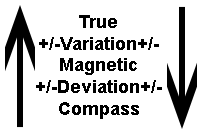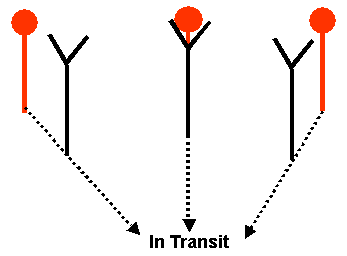Navigation and Chart work - Compass Deviation
Deviation
The effect of variation is the same for all boats in the same area at the same time. Deviation is specific to the boat and the course it is sailing on.
Deviation is caused by iron, magnets and magnetic fields (from electronic equipment), all of which influence the Earth's magnetic field around the boat.
This means that you should avoid placing any of the above items near where you will be using a compass. For the ship's main compass, this is easy enough, but consider the positioning of any loudspeakers for sound systems-will you be using a hand bearing compass near any of them?
Another compass to consider is the electronic fluxgate compass for the autopilot. They are often a black box hidden out of sight in lockers below. It is very easy to then put cans of food near them, and cause a deviation; the effects can be very interesting if the cans roll about in rough weather! If you have an intermittent error in your auto pilot, this is the first thing to check.
Most modern wood or fibreglass boats can reduce deviation to a very small amount, which can be ignored for practical purposes, provided that a suitable place has been found for the compass. If you have a steel or Ferro-cement boat, you will probably have a considerable deviation. This means that you should always have your boat corrected by a Compass Adjuster. Compass Adjusters measure the deviation and by altering the positions of the magnets built in to a compass can reduce the errors to manageable figures.
After your compass has been swung (checked for deviation) and adjusted, a deviation card will be created. An example is shown below, this is similar to the one inside the back cover of your Training Almanac.

From this you can see that the deviation varies with the boat's heading, so for each course we steer, there will be a different deviation to apply. On a course of 000°C, the deviation was 4°W.
On a course of 135°C, the deviation was 6°E.
Deviation is applied in the same manner as variation, but there is a correct sequence to follow.
If you start with a compass course of 270°C (one with variation and deviation), you must find the deviation first, 4°W. Then using CADET; we subtract the deviation to get a magnetic course of 266°M. Using CADET again; we subtract the 7°W variation, to result in a true course of 259°T, which we can plot on the chart. So the sequence can be illustrated as follows:

From the adjacent diagram, if you start with a true bearing of 154°T, and apply 7°W variation the magnetic bearing is 161°M, we then enter the deviation table above to find that the deviation is 5°E, and the compass bearing is 156°C.
It is a good idea to check by running the calculation backwards like this, from a compass bearing to the true, hopefully you will get the number you started with! Occasionally you will find that once you have applied the deviation, that it may be more accurate to choose the next figure for deviation from the table. This occurs because the table is set up for use with compass bearings, but we may be entering it with a magnetic bearing, an example is:
293°T
7°W variation
300°M deviation 5°W is nearest
305°C
Re-entering the table with the compass course of 305°C, the deviation is found to be 6°W.
One degree is not going to matter in most of what we do on small craft, but it is useful to realise the limitation of this type of table. (An error of 1° on a passage of 60M will put the vessel 1M out at the other end of the voyage.)
To sum up;
• A magnetic bearing is a true bearing, to which variation has been applied,
• A compass bearing is a true bearing, to which variation and deviation have been applied.
Swinging the compass
Ideally you will have your compass swung annually; it is particularly necessary after major work on the vessel, if it has been sitting still for some time and after a lightning strike (if it is still afloat!). Other than this there may be occasions when you think that there may be a deviation. The checks are quite simple.
 The most accurate method is to find a transit. A transit is a place where two objects are seen in line, when this occurs we can easily measure the true bearing of the transit on the chart. There are many natural transits, but you will find some marked on charts, particularly on harbour entrances-where they are marked as leading lines. Leading lines frequently have the true bearing when seen from seaward written on the chart. On Chart 4B, there are two leading lines marked, what are the bearings?
The most accurate method is to find a transit. A transit is a place where two objects are seen in line, when this occurs we can easily measure the true bearing of the transit on the chart. There are many natural transits, but you will find some marked on charts, particularly on harbour entrances-where they are marked as leading lines. Leading lines frequently have the true bearing when seen from seaward written on the chart. On Chart 4B, there are two leading lines marked, what are the bearings?
If we know the true bearing, we can add the variation to find the magnetic bearing. Then by comparing this to the compass bearing, we can deduce the deviation.
Point the vessel directly up the transit; this is easy to do when there is no current. Then read the heading on the ship's compass.

If you wish to make up a deviation table you could find transits all the way round from 000° to 360° and workout the deviation. If this is done at intervals of 30°, you will be able to plot a deviation table of your own.
A quick check for deviation, which is not very accurate but will pick up gross errors in wood or fibreglass boats, is to use the hand-bearing compass.
We assume that the hand bearing compass has no deviation, this is not strictly true, but if you stand high up on the stern and sight down the centre line of the boat with the hand bearing compass-any discrepancy between it and the ship's compass is the deviation.
Whilst not particularly accurate, this will work in an emergency. In fact, whenever I skipper an unfamiliar boat, I use this technique on each new course-until I am happy that the compass is correct. It is not unusual to find errors in the region on 10° on new vessels that have not been corrected.
Questions
Convert these magnetic bearings to compass bearings. Use the deviation table above.
1. 090°M What is the deviation and compass bearing?
2. 270°M What is the deviation and compass bearing?
Convert these compass bearings to magnetic bearings.
3. 315°C What is the deviation and magnetic bearing?
4. 025°C What is the deviation and magnetic bearing?
5. On chart 4.
The crew of a vessel see the leading beacons at Endal Marina (46° 13.83'N 005° 46.78'N) in transit, dead ahead when there is no tide. What is the deviation on this heading if the compass reads 150°C?
Deviation on RYA theory courses
On RYA theory courses you will need to apply deviation to bearings when they are compass bearings, the letter 'C' after the bearing will denote this. You will also need to apply deviation if you are asked to find the compass course.
For any question involving deviation, use the table in you training almanac, except when the question is in the form of a compass check to find the deviation.
GPS bearings
Bearings from GPS sets are not magnetic; they are calculated so there is no deviation involved. However, GPS receivers can be set to give bearings as true or magnetic.
Additional Resources:

